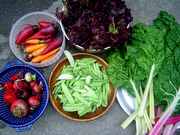

|
| Vegetable Varieties for Gardeners is a citizen science program
|
|
|
|
'Kimberly' Tomatoes |
| |
| Sub-Category: |
Cherry
Early-Season
|
| |
|
| Sub-Category 2: |
| | Description: |
Early-season cherry tomato. Indeterminate, potato-leaved plants bear red, two- or three-celled fruit.
|
| Days To Maturity: |
69
|
| Seed Sources: |
|
| |
| Rating Summary |
| |
Overall: (4.5 Stars)
Taste: (4.0 Stars)
Yield: (4.5 Stars)
Ease/Reliability: (5.0 Stars) |
| |
| Reviews |
| |
Login to share your Review of Kimberly.
Number of Reviews: 2
KEY: O=Overall Rating, T=Taste, Y=Yield, E=Ease
Reviewed on 11/15/2006 by
gardengalrn
- An intermediate gardener
|
 Overall Overall
 Taste Taste
 Yield Yield
 Ease Ease
|
Kentucky, United States
Frost Free Season: 143 - 163 days
Soil Texture: Clay
Garden Size: Medium - 400 square feet to 1,600 square feet
Sun Exposure: 6 to 8 hours per day
|
| This was the earliest ripe tomato by yards in my garden. Very productive and easy to grow. Golf ball sized fruits that were tasty but I did prefer Stupice by a tiny bit. Again, could not keep up with the produce as it sat next to Stupice and between the two, YIKES. Very good for salads, perfect size. |
| |
|
Reviewed on 06/02/2006 by
Cowpoke
- An experienced gardener
|
 Overall Overall
 Taste Taste
 Yield Yield
 Ease Ease
|
Stokes, North Carolina, United States
Frost Free Season: 143 - 163 days
Soil Texture: Clay
Garden Size: Large - More than 1,600 square feet (40' x 40')
Sun Exposure: More than 8 hours per day
|
| My second year growing Kimberly. Very early (plants set out in mid-March produced ripe fruit Memorial Day or 42 days) Not quite as productive as Stupice but flavor is superior. Fruit are actually very large for a cherry; more like a small salad tomato. I am considering replacing Stupice with Kimberly as my early season tomato. An Early Girl set out the same day and grown next to a Kimberly is just beginning to ripen fruit in early June. |
| |
|
|
|
|
Vegetable Varieties for Gardeners is a citizen science program, © 2004-2024, All Rights Reserved
Cornell Garden Based Learning, Cornell University College of Agriculture & Life Sciences, Horticulture Section
|






 VVfG home
VVfG home
 Taste
Taste